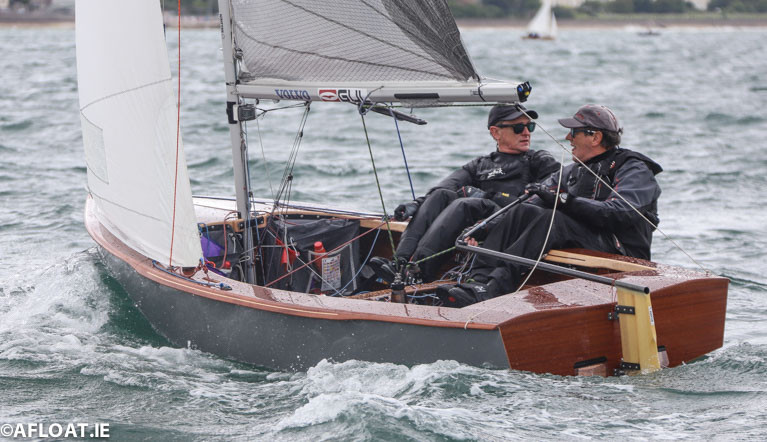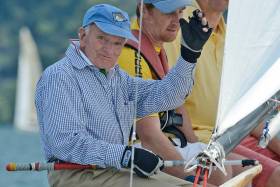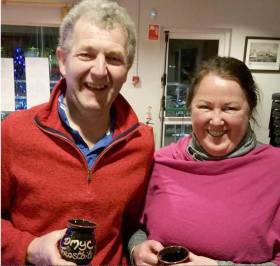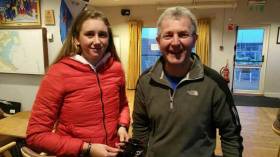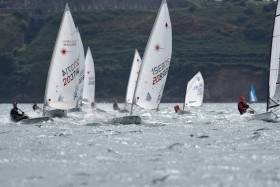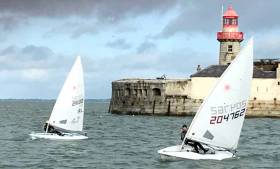Displaying items by tag: Dinghy
25 Dinghies Enjoy DMYC's “Snakes Alive” – Three Race Fiesta at Dun Laoghaire Harbour
While thirty-five boats had entered the extra Bank Holiday DMYC “Snakes Alive mini dinghy regatta, a slightly smaller number actually appeared on the water in Dun Laoghaire Harbour. Of the twenty-five boats that did race, full marks go to the ILCA 4s who had a 100% attendance of the four boats entered – well done to Zoe Hall, Ava Ennis, Dylan de Vreeze and Lucy Nicol who not only appeared but contested all three races.
Next best were the ILCA 7s who had a full suite of three boats, with three finishers in the first race, two in the second and none in the last race as the remaining ILCA 7 offered to start with the PY Fleet – thanks Brian!
The ILCA 6s had fourteen boats entered and eight sailed the first race and seven the remaining two. The PYs also promised fourteen boats with eight answering the starter’s call.
However, how many boats appeared was academic because there was a very favourable reaction from all those who did make it to the water.
 Brian Carroll, 218961 leads Marco Sorgassi 211811 on a downwind leg in the ILCA 6 division
Brian Carroll, 218961 leads Marco Sorgassi 211811 on a downwind leg in the ILCA 6 division
With the wind steady from 150° all afternoon, the course needed no adjustment in terms of the location of the weather mark, utilising the maximum dimension of the harbour it was situated east of the bandstand, with the committee boat in the elbow of the western breakwater and the West Pier. For the first two triangular courses, the gybe mark was set inside the end of the East Pier.
The last race was a shorter two-lap windward-leeward which meant that the gybe mark became the second half of the leeward gate.
 Frank Miller & Neil Cramer, Fireball 14713 (later in the afternoon)
Frank Miller & Neil Cramer, Fireball 14713 (later in the afternoon)
The wind was at its strongest at the start of the afternoon, with the base wind fluctuating around the 15- 17 knots but during the first race 21 knots was recorded on a handheld device. That afforded the fleet a brisk tour of the harbour and Frank Miller & Neil Cramer (FB 14713) availed of the conditions to romp home by a very comfortable margin in Race 1. However, on corrected time, they lost out to the GP14 of Ciara Mulvey & Peter Murphy. Young Conrad Vandlik in the ILCA 7 continued where he has been for a large part of the season, in pole position.
The ILCA 4s were superb with tight racing all afternoon between Zoe Hall and Ava Ennis, but in the breeziest conditions, their willingness and competitiveness to get around the course was fantastic. These two young ladies are petite, but neither gave way to the conditions. Zoe took the first race, but Ava took the second.
 Brendan Foley, Aero 7 1321 – downwind concentration
Brendan Foley, Aero 7 1321 – downwind concentration
In the ILCA 6s, only three boats finished the first race with Marco Sorgassi taking the honours, but their numbers went up for races two and three.
As the afternoon wore on the wind eased and the last race of the day was sailed in 8 – 10 knots. While the ILCAs had “enjoyed” a prolonged training session on the water before racing began, they also seemed to enjoy having three races. There were many others who had a smile on their face at the conclusion of the afternoon.
Snakes’ Alive “Regatta” Friday, March 18th – hosted by Dun Laoghaire Motor Yacht Club


The regular Frostbites return tomorrow (Sunday) for the penultimate round of racing. The forecast now (16:30, Saturday) is for 13 – 17 knots of South-Easterly with sunshine and a temperature of 9°. See you on the water!
DMYC Race Organiser Neil Colin has issued the last shout out for Friday's 'Snakes Alive' dinghy event at Dun Laoghaire Harbour.
"It looks like St Patrick is providing us a spectacular day for sailing on Friday, let’s hope the Hangovers are not too bad and we are all able to get out of bed on the 18th for the “Snakes Alive” event to be run from the DMYC on the successful Frostbite format, Colin told Afloat.
As Afloat reported previously, the 'Pop Up' dinghy race for the Public Holiday on March 18th, is in place of the weather-related, lost races in the club's Viking Marine Frostbite Series since Christmas.
The races will not count in the series results, but DMYC race mugs will be presented to daily winners.
The “Snakes Alive” Open Event will be held in the Harbour and details can be found here.
Entrants to the Frostbite Series have a free pass, and others are encouraged to register online and make a lifeboat donation.
"We are requesting all entrants to register in advance of sailing, to ensure we have a starters list to assist the record-keeping and base results on', Colin said.
Day winners across the classes will be presented in the DMYC bar afterwards, with the possibility of watching the Friday evening Six Nations match also on offer.
Mixed Dinghies On the Way Back in Cork Harbour
The Royal Cork YC is hoping to re-establish the ‘Mixed Dinghies’ Class at the Crosshaven-based club in Cork Harbour.
“Having been very quiet for a few years, the mixed dinghy fleet is making a comeback this season,” the club has told its, members, with an appeal for more support: “We would like to hear from everyone interested in getting on the water in double-handed boats, from beginners to advanced, young and old, from Topaz to RS400 and everything in between.”
“This fleet offers a great blend of social sailing with the opportunity to race and participate in events also,” says Maurice Collins, RCYC’s Rear Admiral Dinghies.“With a wide range of boats and age groups accommodated, it brings all our sailors together. It is an opportunity to explore sailing with friends usually in a multi-handed dinghy, but not confined to multi-handed dinghies.
 Maurice Collins, RCYC’s Rear Admiral Dinghies Photo: Bob Bateman
Maurice Collins, RCYC’s Rear Admiral Dinghies Photo: Bob Bateman
“There is a limited number of club boats available for those starting out and for those with a boat and maybe looking for a crew, this is a great opportunity. If you have your own single-handed dinghy. but there is not a class in the club to join, please join in and sail along with the mixed dinghies.”
To gauge the level of interest and to explore what RCYC dinghy sailors are interested in, the club is carrying out a ‘Mixed Dinghy fleet survey.’
 A 49er skiff and a GP14 compete in a mixed dinghy handicap fixture at Royal Cork Photo: Bob Bateman
A 49er skiff and a GP14 compete in a mixed dinghy handicap fixture at Royal Cork Photo: Bob Bateman
“For those eager to get sailing and racing, we have the very social Ramen PY1000 race on Saturday, March 26,” says Maurice Collins,” with the Round Island and Coolmore races coming up later in the season.
“If we have enough interest, we intend to set up a mixed dinghy club racing series during the Summer months.”
With several dinghy classes already in the club, it will be interesting to see what response the appeal gets.
Adults Sail Dinghies Too
I learned my sailing crewing aboard a National 18 in Cork Harbour. That opportunity came through an adult sailing course because it was in my late 20s that I gained access to the sport.
Back then was not a time when getting into sailing was as easy as it is today. From crewing I bought a new Mirror dinghy and then a Vagabond, because it was the dominant dinghy fleet at the time in the club I joined - Monkstown Bay SC. At one stage there was a fleet of 30 of these 12ft. dinghies, which didn’t carry a spinnaker like the Mirror, but which was more attractive for me – because Vagabonds were raced by parents and their children. It was a great class. Fathers, mothers, sons, daughters, crewed for each other. The class had so many boats it qualified to have annual ‘national championships’ under then Irish Sailing Association regulations.
So adults sailed dinghies too!
But, gradually, ageing affected the Vagabond fleet, parents got older, younger and often better sailors took over in the natural evolution of things. The fleet continued to thrive until those youngsters moved on, getting jobs, moving away from the village and, gradually, the fleet died out.
Some of those young sailors went onto cruisers, others were lost to the sport, underlining a discussion which has followed my Podcast two weeks ago on the Irish Cruiser Racing Association’s Under 25 scheme, to encourage young sailors to get into cruisers as they come to an age when dinghies may no longer be their choice.
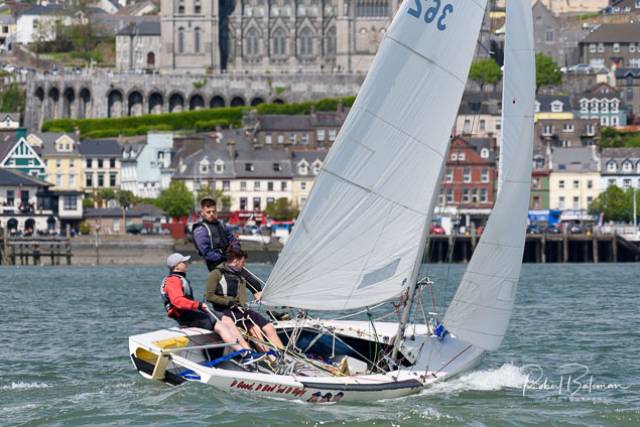 National 18 dinghy sailing in Cork Harbour Photo: Bob Bateman
National 18 dinghy sailing in Cork Harbour Photo: Bob Bateman
But, of course, there are adults who sail dinghies too. The National 18 fleet, where I learned to sail, is thriving in Cork Harbour. There are adults crews and fleets of Mermaids. Dublin Bay and Foynes are places I’ve reported about them. There are adult-crewed and active fleets of Wayfarers, Albacores, Lasers and others at various clubs and even, as has been pointed out to me, adults sailing Mirrors. Then there are other ‘open’ and ‘keel’ boats, the 1720s and 505s, Squibs and others, that are not cruisers, so there are other opportunities for young sailors to stay active in the sport.
"My underlying point is that adults sail dinghies too – so this is also an avenue for youngsters to remain in the sport …"
I was discussing this with Brian Raftery of ICRA whom I interviewed about the Under 25 cruiser racing programme to keep young people in sailing which he is leading. Listen to Brian Raftery here. He is a member of Sligo Yacht Club which has a very active GP fleet, a boat in which adults also sail in several clubs. “There are twenty GP14s in the dinghy park, 10-12 racing each week making up less than half of the club’s adult sailors. Nationally the GP is the biggest adult dinghy fleet in the country with about 40 boats at its National Championships every year,” he told me and added that the GP's have been successful in getting younger sailors into their fleet.
He said that he would “love to see someone take on the Under 25 area within dinghies.”
That is a good point. Why not?
As dinghy classes tend to operate somewhat in isolation in the sense of the various clubs where they are active, rather than the wider ambience of national cruiser organisation, it may be harder to develop a national/cross/class dinghy U25 approach.
My underlying point this week is that adults sail dinghies too – so this is also an avenue for youngsters to remain in the sport …
The important thing is to – KEEP ON SAILING.
• More on the Podcast below
Stuart Walker, 1923-2018
American dinghy racing legend Stuart Walker has passed away at the age of 95.
Dr Walker was a paediatric specialist by day, but outside the hospital was a key figure in Annapolis, Maryland’s sailing scene — co-founding in the mid 1950s the Severn Sailing Association which still produces many of America’s top dinghy sailors.
An Olympian who represented the US in the International 14 class throughout the 1960s, Dr Walker was also an accomplished sailing writer, with a longstanding column for what’s now Sailing World magazine and numerous books on sailboat racing to his credit.
“Certainly my name has spread through my writing, but my articles would not have credibility if there wasn’t success behind it,” he told Annapolis’ Capital Gazette at a party for his 90th birthday.
DMYC Dinghy Frostbites on the Double!
The fifth round of the 2017/18 Frostbites, hosted by Dun Laoghaire Motor Yacht Club, saw two races held inside the harbour, a four lap trapezoid course to start proceedings followed by a three lap windward-leeward course which I am reliably informed is a first for the Frostbites, so kudos to Race Officer Brian Mulkeen writes Cormac Bradley. It also saw the best turnout of Fireballs, six and a healthy fleet of Lasers, fourteen. In addition to the six Fireballs the Fast PY Class included the 470 and Tom Murphy’s K1. In the Slow PY the fleet was made up of a Wayfarer, a Solo, a solitary KONA (Windsurfer), a Feva, 2 IDRAs, 2 Enterprises, 4 Laser Vago XDs and a Hartley 12.2.
The weather station in the harbour was recording 15.9knots with a gust of 21.8knots from 284˚ with an air temperature of 9˚. This meant that the “on-the-water” situation was pretty consistent with the XCWeather prediction for the afternoon. The afternoon started under partial blue skies but the skyline greyed as the afternoon progressed and there was a lit bit of drizzle later one. For the trapezoid course the weather mark had been set under the West Pier of the harbour at the location of the first “elbow” in the wall – where it changes direction. No.2 seemed to be a long way downwind of the first mark, almost disproportionately so, but during the race mark 1 – 2 was invariably tight. Mark 2 – 3 was an easier sail with some boats electing to gybe before reaching No.3 so as to set themselves up for a very tight 3 – 4 leg. Mark 3 was located off the HSS gantry and Mark 4 was of the order of 120m east of the mouth of the harbour.
In all three starts the fleet went left initially. In the slow PY, the Wayfarer was the weather-most boat and that set Monica Schaeffer and Miriam McCarthy up for the lead and the privilege of leading the Slow PY fleet around the first weather mark. However, they were kept in close company for the first lap by the Solo of Shane McCarthy before he was able to pull away from them. Both would fall victim on the water to the Kona Windsurfer of Robbie Walker who led for the majority of the race.
The Fireballs were stacked windward to leeward on a port tack coming out of the start towards the middle of the harbour. Using headgear and clothing combinations to identify boats it looked as though Louise McKenna & Hermine O’Keeffe (14691) were the furthest boat to windward with Neil Colin & Margaret Casey (14775) furthest to leeward. In between were Noel Butler & Marie Barry (15061), Alistair Court & Gordon Syme (14706), Frank Miller & Grattan Donnelly (14713) and David and Michael Keegan (14676).
While the boats which came furthest left seemed to have got in to better wind, Butler & Barry, having tacked earlier were able to get around the weather mark first but it was close with Miller & Donnelly and Court & Syme. Colin & Casey were a short distance behind them while McKenna & O’Keeffe and Keegan & Keegan were a little off the pace.
Court & Syme powered over Miller & Donnelly on the tight reach between 1 and 2 and spent the rest of the race chasing Butler & Barry. On the subsequent beats, the addiction to going left was diluted somewhat with a preference to staying on the right-hand side as far as the harbour mouth, before tacking across to the middle of the harbour. The exception to that rule was Colin & Casey who tacked early every time to work the middle and left of the beat. On the third lap, Butler pulled away from Court and both boats put distance between themselves and the remainder of the fleet. By Mark 3 of the penultimate lap, Butler & Barry were the third boat on the water behind the Kona and the Solo and by the penultimate rounding of Mark 4 Court & Syme were ahead of everyone bar the Kona and the Solo. The tightness of the leg from 3 to 4 meant that in Round 3 Butler & Barry went for an Aussie drop two-thirds of the way down the leg while the all male combinations behind them, Court and Miller were able to hold the spinnaker all the way into the mark.
While Butler was comfortably ahead at the last windward mark, he nearly got caught by Court who was able to close in better wind with Syme on full trapeze between 1 and 2 while Barry was sitting inboard with a limp spinnaker. However, a late change in leader did not materialise and Butler & Barry won by 50 seconds with only he Kona ahead of them on the water. Court finished third on the water, getting ahead of the Solo just before the last weather mark. Colin & Casey put together a fast last lap, closing dramatically on Miller & Donnelly in the approach to Mark 4 for the last time, but Miller held on to finish third. In the slow PY fleet, the order on the water was Kona, Solo, Wayfarer, Feva, and Enterprise.
The ice was broken (figuratively) when a second race was set for the afternoon. Marks 2 and 3 were lifted and a windward-leeward was set with Marks 1 and 4 staying “as is”. Again, the majority view in all starts was to go left – there were no dissenters in the Slow PY start, 4 Lasers went right and while all the Fireballs started on port tack, two went right quite early on – McKenna and Keegan. Colin was furthest away from the committee boat at the start. At the top mark, Miller led the fleet around followed by Butler, Court and Colin. While the first three stayed on starboard tack, Colin gybed and sailed towards the harbour mouth. Behind these four, McKenna and Keegan had their own race. Miller held the lead down to 4 and stayed ahead up the next beat. In this regard he was helped by being on starboard with a Laser also being on starboard to force Butler to take evading action relative to both boats two-thirds of the way up the second beat. At the windward mark for the second time, Colin was still in fourth, but took a line that brought him down the right hand side of the run relative to the others who were all to his port-hand side. In this position he managed to sail through Court and close the gap on the first two, but Court nipped in again at the leeward mark to relegate him back to fourth again. McKenna and Keegan were also having a “ding-dong” battle on the downwind leg.
Up the final beat and Court stays right whereas the others come left. Butler gets through Miller and Colin is promoted to third as he, Miller and Butler come in on the starboard lay-line. Court’s race come to an early end when he gets caught up in a melee at the weather mark and decides that discretion is the better part of valour and retires home early. Butler and Miller dice again on the last downwind leg but Butler secures the inside berth on the approach to the leeward mark and has enough room to squeeze Miller out and to enough of a degree to make the short hitch to the finish a “safe bet”.
In the Fast PY fleets, the Fireballs all saved their time on the water in both races which means that the Frostbite Mugs for the day go to Alistair Court and Gordon Syme for the first race of the day and to Neil Colin and Margaret Casey for the second race.
|
DMYC Frostbites: Overall Fast PY Fleet |
|
R1 |
R3 |
R4 |
R5 |
R6 |
Tot |
|
|
1 |
Noel Butler & Marie Barry |
FB 15061 |
1 |
2 |
1 |
1 |
1 |
6 |
|
2 |
Frank Miller & Ed Butler/Cormac Bradley/Grattan Donnelly |
FB14713 |
2 |
5 |
2 |
3 |
2 |
14 |
|
3 |
Neil Colin & Margaret Casey |
FB14775 |
3 |
7 |
3 |
4 |
3 |
20 |
|
4 |
Alistair Court & Gordon Syme |
FB14706 |
7 |
3 |
5 |
2 |
8 |
25 |
47th Dun Laoghaire Dinghy Frostbite Series Gets Underway!
The 47th running of Dun Laoghaire Motor Yacht Club’s Frostbite Series got underway yesterday in blue sky, sunny conditions and a brisk N-Westerly that reduced in strength as the afternoon wore on writes our special correspondent. Stalwart of the event, Olivier Prouveur, who announced at the conclusion of the 2016/17 Series that he would be taking a less prominent role in the managing of the event was in attendance, but in an observer role!
The Race Officer duty was undertaken by Frostbite RO debutant Cormac Bradley of the Fireball Class and for his first foray into the Frostbite Race Management the first decision was to decide if racing would take place. An early departure from DMYC with a suggestion that a postponement would be advised, if necessary, was vindicated when the assessment was that racing could proceed.
In a departure from previous formats, three starts were provided – Slow PY, (PY1), Lasers and Fast PY (PY2). And in a significant development, two windsurfers of the KONA Class joined in the racing.
Given the conditions and the “first day back” nature of the day, a single race was proposed and sailed with 5 laps of a trapezoid course used to wash away the cobwebs. Given that the keelboats, sailing their Turkey Shoot Series earlier in the morning, did not seem to be excessively hard pressed and taking into account the physical condition of the waters inside the harbour, the postponement wasn’t required and racing got underway on schedule, at 14:00.
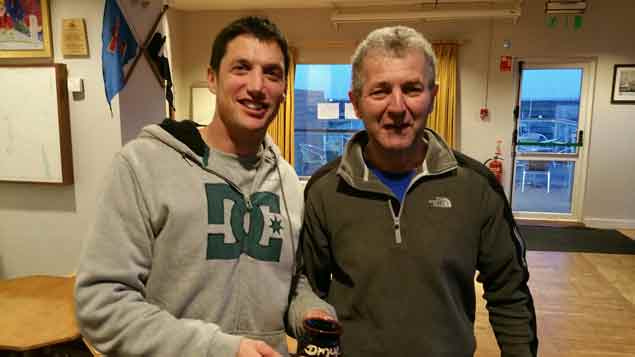 Solo sailor Shane McCarthy (left), the Slow PY Class winner with DMYC's Neil Colin Photo: Frank Miller
Solo sailor Shane McCarthy (left), the Slow PY Class winner with DMYC's Neil Colin Photo: Frank Miller
As an experiment the two windsurfers were put in PY1, the argument being that if they were as fast as we thought they might be they would get away from the rest of the fleet and have less traffic to deal with on the race course. Their contemporaries on the first start were a Solo, an IDRA 14 and four Laser Vagos. One of the Konas led at the first weather mark, sitting about 60m inside the harbour mouth and closer to the end of the West Pier, but the Solo was not far behind. By the time they got to the end of the five laps, the windsurfer had a good lead on the Solo on the water, but was unable to save his time in handicap terms. In third place on the water was the IDRA of Pierre Long & John Parker. Marks 2 and 3 were in the vicinity of the approach to the marina and just east of the ferry terminal respectively and while spinnakers were a rarity on the top leg of the trapezoid, they were flown on the leg from 2 to 3. Again, only the asymmetrics had any real joy with spinnakers on the bottom leg of the course. Mark 4 was in the approximate location of the memorial on the East Pier.
The finishing order on the water was Kona, Solo, IDRA, but after handicap correction the win went to the Solo of Shane McCarthy with the windsurfer second and the IDRA third.
Ten Lasers answered the starter’s call, with three Radials in the bunch. And it was one of the Radials, helmed by Clare Gorman who set the pace for the first half of the course. Eventually she was reeled in by Gary O’Hare who went on to win on the water by 24 seconds, but after handicap correction, Gorman took the first Laser Frostbite Mug by a margin of 1:09. In third place was Richard Tate.
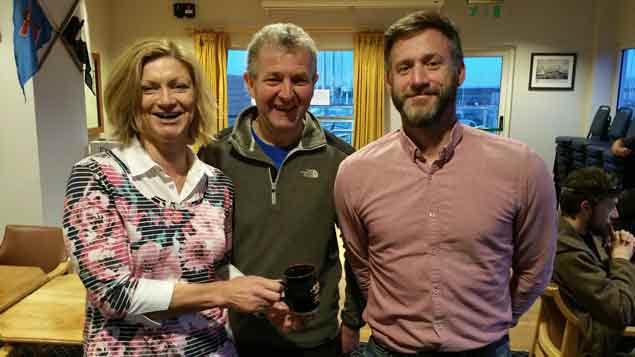 Fireballers Marie Barry and Noel Butler (right) the fast PY Class winners with DMYC's Neil Colin Photo: Frank Miller
Fireballers Marie Barry and Noel Butler (right) the fast PY Class winners with DMYC's Neil Colin Photo: Frank Miller
Six Fast PYs populated the last start of the day, four Fireballs, a K1 and an RS400. Noel Butler with new crew, Marie Barry (15061) led the fleet from start to finish and won with a 1:24 margin. They weren’t seriously troubled at any stage of the race and even tired spinnaker on the top reach but the blustery nature of the wind coming over the wall suggested that discretion was the better part of valour. Behind them, the battle was for second and third and was populated by Frank Miller & Ed Butler (14713) and Neil Colin & Margaret Casey (14775). While the former pair had the better start and led during the early part of the race, they were undone by an incident with a Laser at one of the leeward mark roundings. The Laser went the wrong side of the mark and got his mainsheet snagged on the mark. This cause him to go into a slow painful capsize with his mast and main snagging the trapeze wire of crew Ed Butler who subsequently went swimming. However, Miller & Butler recovered to take second place back from Colin & Casey. They cut it very fine though, only six seconds separating the two boats. The Fireballs, Butler & Barry, Miller & Butler, Colin & Casey and son and father combination, David & Michael Keegan (14676), were the first four boats home and on handicap. Tom Murphy (K1) only just beat the RS400, helmed by Stuart Harris, on the water, but beat them more comfortably on corrected time.
During the hour’s racing the wind eased as forecast and the blue sky conditions made for a good day out. Frostbites 2017/18 is up and running.
DMYC’s Frostbites 2017/18 – Day 1.
PY1 – Slow Handicap
1 Solo Shane McCarthy Coal Harbour 5302
2 Kona TBA 1969
3 IDRA Pierre Long & John Parker DMYC 161
4 Kona Des Gibney 2677
Lasers
1 Radial Claire Gorman NYC 207800
2 Full Gary O’Hare RStGYC 201364
3 Full Richard Tate 186300
4 Full Gavan Murphy 173062
PY2 – Fast Handicap
1 Fireball Noel Butler & Marie Barry NYC 15061
2 Fireball Frank Miller & Ed Butler DMYC 14713
3 Fireball Neil Colin & Margaret casey DMYC 14775
4 Fireball David & Michael Keegan RStGYC 14676
5 K1 Tom Murphy NYC 59
For a first day of the series, the entries were down on previous years, this was assumed to be a combination of the forecast, the preceding week’s mid-term break for schools and the usual need to get momentum developed. The organisers would welcome more entries in the forthcoming Sundays.
Royal Cork Yacht Club's Rapid Rise In Dinghy Sailing Activity
As the debate rumbles on as to how we can engage more young people in the sport of sailing, the Royal Cork Yacht Club has witnessed 'tremendous growth' in junior dinghy sailing activity across every level over the last eighteen months writes RCYC Rear Admiral, Stephen O'Shaugnessy.
The club currently boasts some of the largest active dinghy fleets in the country; The Optimist class for example, has in excess of seventy sailors right across an age range from 8 -15 years old. Equally, the club Laser and Topper fleets have also seen rapid growth in numbers participating on a consistent basis at both club and regional level.
In tandem to all this single–handed dinghy activity, there is a growing fleet of RS boats being purchased by members and this appears to be filling a gap to ensure that junior members in their late teenage years keep sailing. While this is very much work in progress, the signs are positive for further growth for two handed sailing across a number of classes, including a possible 29er class.
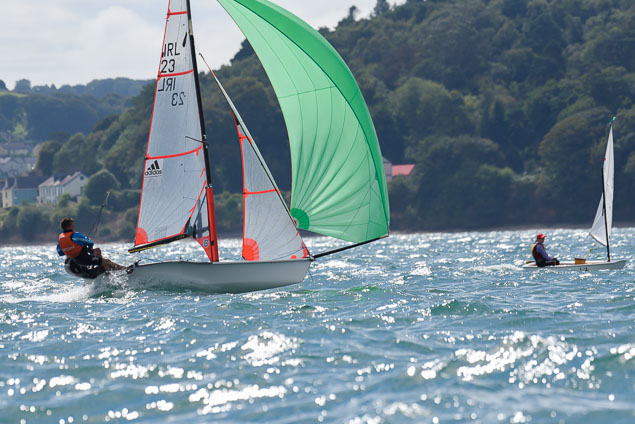 Signs are positive for further double–handed dinghy growth in classes such as the youth 29er skiff. Photo: Bob Bateman
Signs are positive for further double–handed dinghy growth in classes such as the youth 29er skiff. Photo: Bob Bateman
The result of all this is an average of ninety dinghies currently taking to the water at weekends to take part in club league racing a coaching programmes.
So what is driving this growth? A very focused junior dinghy committee ensures that every base is covered when it comes to our junior activity in the club. Underlying all our activity is the fundamental belief that every junior member is a fantastic asset to the club, irrespective of their age, ability or ambition. All our club coaching programmes and courses are structured in such a manner that the sailors within each fleet feel a strong sense of identity of being part of a larger team even though they each may well have different goals or objectives in terms of competing at various levels or simply sailing for the love of sailing'.
The spin off from all this activity has also helped towards a substantial increase in those participating in their club summer sailing courses. This, coupled with the fact that a growing number of family members are encouraging their children to be more involved in healthy outdoor activity during the summer months has led to one of the largest summer programmes in the country this year with in excess of hundred and seventy participants.
Looking to the future, the hope is to further build on the philosophy that as a sport, sailing is a skill for life that can be enjoyed at any stage and at any age and whatever ability.
There is clearly a growing demand across Ireland for dinghy sailing at every level and the club looks forward to continued growth in the build up to its 300th anniversary in 2020.
'Final Fling' is Flung for Dinghy Season at Dun Laoghaire
‘The Final Fling is Flung’ commented one competitor as he painfully dragged his boat up the slipway in Dun Laoghaire. Strong north-easterly’s greeted the fleet on Sunday afternoon.
With a healthy entry of 22 boats, from four different dinghy fleets – the effects of the 'weather bom'b that was Storm Brian caused the postponement of racing by 24 hours. Three races with no discard were held in the Harbour.
In the Feva fleet – Elysia O’Leary and Lilly Dwyer took top spot in the testing conditions.
Laser Standard – Conor O’Leary sailed solidly to take first overall – with the rest of the fleet decimated by gear and body failure!
 Royal St. George's Toby Hudson Fowler, sporting the overall Final Fling prize!
Royal St. George's Toby Hudson Fowler, sporting the overall Final Fling prize!
Laser Radial first overall was decided on the last mark rounding of the last race with young gun Toby Hudson-Fowler getting the better of Dinghy Master Sean ‘Recently Radialised’ Craig. First Female was Shirley Gilmore.
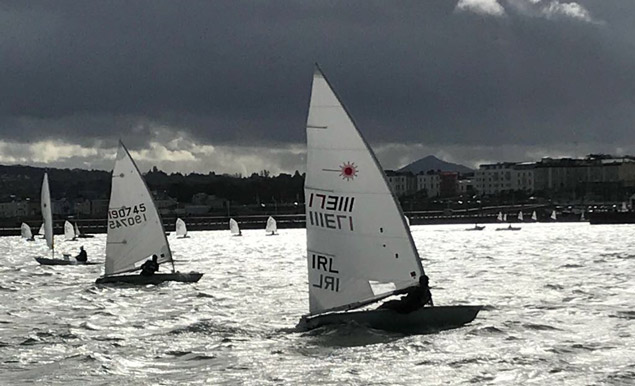
The Waspz fleet wisely stayed at home!
Final Fling 2017 showcased the competitive Dinghy racing is provided by DBSC each Tuesday evening during the summer – Overall regatta winner Toby commented that he will ‘definitely joining in next year and will be dragging along some of his young radial sailor mates’…
If any other Dinghy fleets want to get involved or make Tuesday evening dinghy racing part of their training plans for 2018 please let us know now!
Thanks to RO Michael Tyrell & Crew, DBSC for providing committee and patrol boats and host club Royal St George.
Final Fling 2018 – 29/9/18 – one for the diary!
Results here
Royal St. George Stages 'Final Dinghy Fling' at Dun Laoghaire
An end of Season race for all Dublin Bay Dinghies fleets is taking place on Saturday, 21st October. To be called the 'Final Fling 2017', the new fixture is supported by DBSC and hosted by Royal St. George Yacht Club.
The racing will showcase dinghy racing that takes place on Dublin Bay run by DBSC every Tuesday evening during the summer, according to organiser Ross O'Leary, a DBSC Laser helmsman.
With quick 1-2-3 starts, four sprint races lasting 30 to 35 minutes aim to guarantee some fun, competitive racing.
All fleets welcome. Entry €20 per boat on the day.
An Apres Sail will be held in the Royal St. George Yacht Club.
Register your entry now: email [email protected] text/call/WhatsApp 087 6642297. Download the poster below.



























